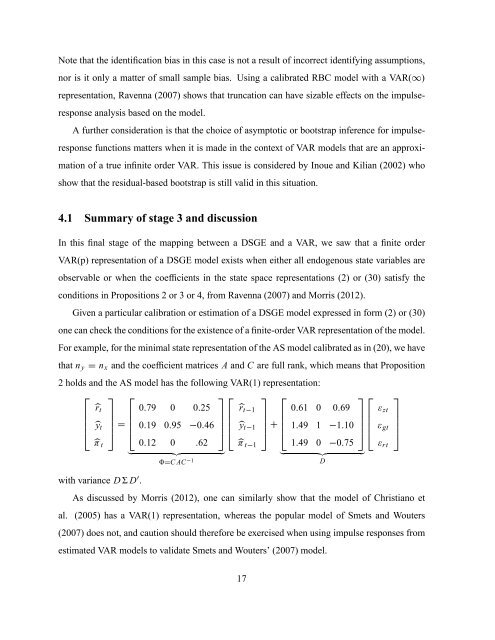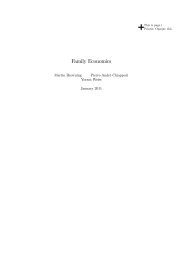The relationship between DSGE and VAR models - cemmap
The relationship between DSGE and VAR models - cemmap
The relationship between DSGE and VAR models - cemmap
You also want an ePaper? Increase the reach of your titles
YUMPU automatically turns print PDFs into web optimized ePapers that Google loves.
Note that the identication bias in this case is not a result of incorrect identifying assumptions,<br />
nor is it only a matter of small sample bias. Using a calibrated RBC model with a <strong>VAR</strong>(1/<br />
representation, Ravenna (2007) shows that truncation can have sizable effects on the impulseresponse<br />
analysis based on the model.<br />
A further consideration is that the choice of asymptotic or bootstrap inference for impulseresponse<br />
functions matters when it is made in the context of <strong>VAR</strong> <strong>models</strong> that are an approximation<br />
of a true innite order <strong>VAR</strong>. This issue is considered by Inoue <strong>and</strong> Kilian (2002) who<br />
show that the residual-based bootstrap is still valid in this situation.<br />
4.1 Summary of stage 3 <strong>and</strong> discussion<br />
In this nal stage of the mapping <strong>between</strong> a <strong>DSGE</strong> <strong>and</strong> a <strong>VAR</strong>, we saw that a nite order<br />
<strong>VAR</strong>(p) representation of a <strong>DSGE</strong> model exists when either all endogenous state variables are<br />
observable or when the coefcients in the state space representations (2) or (30) satisfy the<br />
conditions in Propositions 2 or 3 or 4, from Ravenna (2007) <strong>and</strong> Morris (2012).<br />
Given a particular calibration or estimation of a <strong>DSGE</strong> model expressed in form (2) or (30)<br />
one can check the conditions for the existence of a nite-order <strong>VAR</strong> representation of the model.<br />
For example, for the minimal state representation of the AS model calibrated as in (20), we have<br />
that n y D n x <strong>and</strong> the coefcient matrices A <strong>and</strong> C are full rank, which means that Proposition<br />
2 holds <strong>and</strong> the AS model has the following <strong>VAR</strong>(1) representation:<br />
2 3 2<br />
3 3 2<br />
3 2 3<br />
br t 0:79 0 0:25 br t 1 0:61 0 0:69 " zt<br />
6 by<br />
4 t 7<br />
5 D 6 0:19 0:95 0:46 7 6 by<br />
4<br />
5 4 t 1 7<br />
5 C 6 1:49 1 1:10 7 6 "<br />
4<br />
5 4 gt 7<br />
5<br />
b t 0:12 0 :62 b t 1 1:49 0 0:75 " rt<br />
| {z }<br />
| {z }<br />
D<br />
with variance D6 D 0 :<br />
8DC AC 1 2<br />
As discussed by Morris (2012), one can similarly show that the model of Christiano et<br />
al. (2005) has a <strong>VAR</strong>(1) representation, whereas the popular model of Smets <strong>and</strong> Wouters<br />
(2007) does not, <strong>and</strong> caution should therefore be exercised when using impulse responses from<br />
estimated <strong>VAR</strong> <strong>models</strong> to validate Smets <strong>and</strong> Wouters' (2007) model.<br />
17













